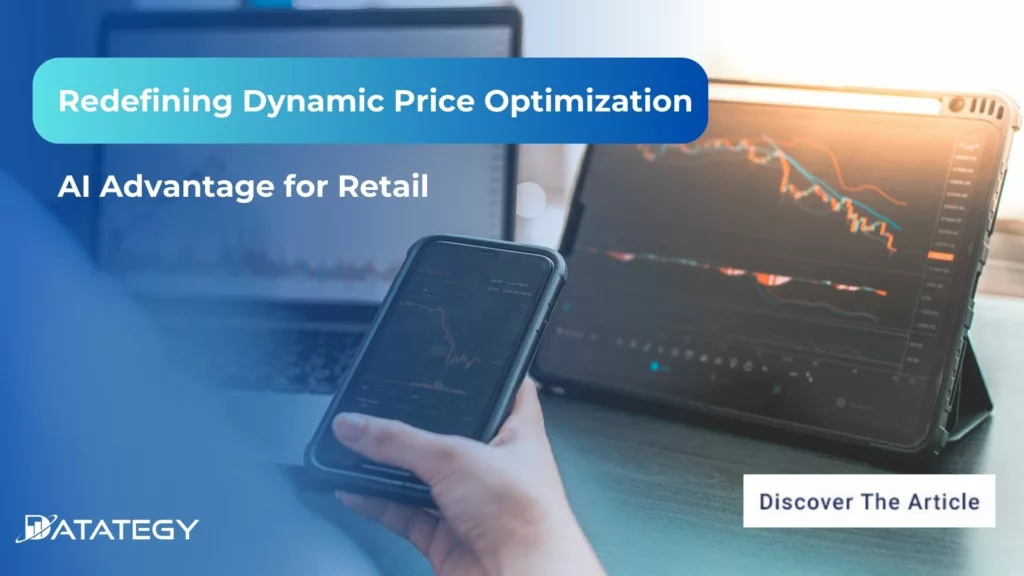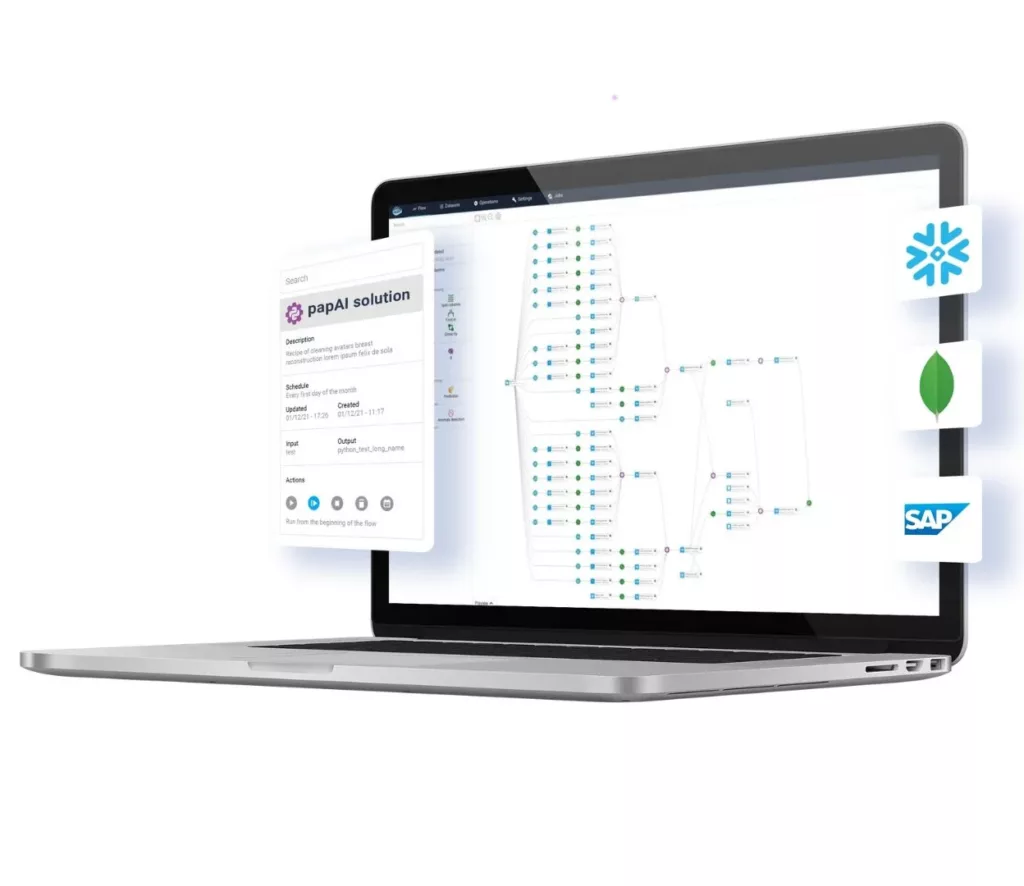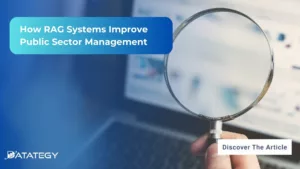How Law Firms Use RAG to Boost Legal Research RAG...
Read MoreRedefining Dynamic Price Optimization: AI Advantage for Retail
Table of Contents
ToggleIn today’s retail market, competition is not just about the product you sell, but also about the price consumers can pay for your product. To address this issue, dynamic pricing strategies have emerged as a revolutionary approach to improving sales, productivity, and competitiveness. The latest McKinsey study shows that using a dynamic price optimization strategy can increase profits by 10-20%.

What does Dynamic Price Optimization Mean?
Moving beyond the conventional fixed pricing models, dynamic price optimization is a more advanced approach. Fundamentally, it entails constantly modifying the costs of goods or services in response to data from the live market, variations in demand, and other outside variables.
Because dynamic pricing is flexible and adaptable to the constantly shifting market conditions, it is preferable to static pricing, which is fixed for a longer length of time.
Essentially, in order to quickly analyze large volumes of data, Dynamic Price Optimisation depends on the use of cutting-edge technology, specifically artificial intelligence and machine learning algorithms. Businesses may maximize their profitability by optimizing their pricing strategy in real-time by studying rival pricing, consumer behavior, and general market trends.
In today’s fast-paced market environment, this dynamic strategy helps businesses seize opportunities, maintain their competitiveness, and quickly adjust to shifts in demand, eventually creating a more robust and flexible company model.
Why is Dynamic Price Optimization with AI important?
In today’s fast-paced and competitive business market, dynamic pricing optimization using AI is essential for several compelling reasons.
First off, the old static pricing models are insufficient to fulfill the demands of dynamic marketplaces since they stay set for lengthy periods of time. Businesses can instantly adjust to changes in customer behavior, market trends, and rival price plans thanks to AI-driven dynamic pricing. Because of their flexibility to adapt, businesses may make the most of their pricing strategies in order to maximize earnings, seize new opportunities, and maintain an advantage in a market that is always changing.
Second, pricing plans now have access to a degree of accuracy and sophistication that was before unreachable thanks to AI. To create data-driven and well-informed price decisions, machine learning algorithms examine enormous volumes of data, including competition pricing, historical patterns, and consumer preferences.
This improves pricing accuracy while also allowing companies to establish the best rates for various market niches and circumstances. As a result, pricing is more responsive and precisely calibrated to match the market’s dynamic character, which eventually boosts profitability.
Furthermore, AI-powered dynamic pricing optimization is necessary to stay competitive. A strategic advantage in sectors where price wars are widespread is the capacity to flexibly modify pricing in reaction to changes in the market and competitor activities.
AI makes it possible for companies to put proactive and responsive pricing policies into place, which helps them remain flexible and strong in the face of shifting market conditions. The potential of dynamic pricing optimization with AI to increase accuracy, drive profitability, and guarantee long-term competitiveness in the demanding business climate of today is, in essence, what makes it so important.
Use cases for Dynamic Price Optimization using Artificial intelligence
1- Adaptive Pricing for Seasonal Products:
For seasonal items, on average, we see a 15% increase in retailers’ sales during peak seasons.
dynamic pricing using AI requires a sophisticated strategy to maximize income in reaction to market dynamics. Artificial intelligence (AI) systems are able to automatically modify pricing during periods of strong demand by examining past sales data and current market patterns.
For example, the system may automatically raise pricing to take advantage of the increased demand when customer interest peaks, guaranteeing optimum revenue. On the other hand, pricing can be dynamically changed to boost sales during times of low demand, limiting the accumulation of surplus inventory and according to market conditions.
2- One-time deals and flash sales:
During flash sales and limited-time deals, AI’s contribution to dynamic pricing is most evident.
During these limited-time sales, retailers automatically modify pricing by utilizing AI algorithms. By using real-time data analysis and consumer reaction tracking, the system can optimize pricing and provide a sense of urgency that increases sales and customer engagement. Promotions are made guaranteed to be both strategically matched with market circumstances and attractive by means of dynamic pricing adjustments.
Based on data from e-commerce platforms, dynamic pricing during flash sales and limited-time offers, backed by AI algorithms, has increased customer engagement by 25% and sales conversion rates by 30%.
3- Pricing Adjustments by Region:
AI considers geographical differences in demand and purchasing power, adding a geographic component to dynamic pricing.
Dynamic pricing considering geographic variations has contributed to a 17% improvement in market penetration for businesses expanding into new regions.
Retailers may maintain competitiveness in various marketplaces by constantly adjusting prices depending on regional considerations. Businesses may improve their worldwide competitiveness by tailoring their pricing strategies to varied regions and taking into account the unique consumer behaviors and economic realities of each area.
4- Loyalty programs and dynamic discounts:
Implementing adaptable discount structures and customized reward programs is made possible by AI-driven dynamic pricing.
AI may automatically modify incentives and discounts to maximize client engagement by examining consumer behavior and market dynamics. This guarantees that incentives stay effective and current, dynamically adjusting to market trends and shifting client preferences, ultimately promoting repeat business and long-term customer loyalty.
Capgemini report shows that AI-powered loyalty programs can increase customer lifetime value by up to 10% through personalized rewards and offers.
5- Promotional Efficiency Evaluation:
AI makes it easier to analyze previous promotions’ efficacy in-depth. Retailers learn from past promotions’ performance by looking at sales statistics, consumer feedback, and market circumstances.
Retailers may use this insightful knowledge to refine their future promotional campaigns for the best possible outcomes. The use of dynamic price modifications in response to prior promotion lessons learned improves the overall efficacy of marketing initiatives by guaranteeing that promotional actions are not only captivating but also strategically linked with changing market dynamics for long-term business success.
According to the last studies, AI-driven promotional effectiveness analysis has resulted in a 25% improvement in the return on investment (ROI) for marketing campaigns.
AI for Retail: A Comprehensive Guide to Choosing the Best Solution for Your Business Needs
When choosing an AI solution, consider factors such as integration with existing systems, data privacy and security, compatibility with your business needs, and scalability. By carefully evaluating these factors, you can choose an AI solution that will help your retail business thrive in an ever-changing market.

How can you Effectively Implement AI in your Organisation?
To implement a good AI strategy in your organisation, you need to take the following steps:
1- Assess Your Organizational Needs:
Start by performing a comprehensive analysis of the requirements and difficulties facing your company. Determine the concrete ways that artificial intelligence (AI) may improve consumer experiences, decision-making, or process optimization. This first action lays the groundwork for a focused and successful AI deployment plan.
2- Establish Clear Objectives:
Clearly state the goals you have for using AI. Whether the purpose is to increase revenue, boost customer happiness, or improve operational efficiency, having clearly stated objectives offers a path forward for the whole implementation process.
3- Identify Suitable AI Solutions:
Make sure the AI solutions you choose meet the needs and objectives of your company. Think about things like interoperability with current systems, scalability, and the standing of the AI companies. The solutions you have selected should be easy to incorporate into your workflow and immediately aid in accomplishing the goals you have set forth.
4- Start with Pilot Projects (POC):
Start with small-scale test projects to get the AI implementation process started. These projects provide as testing grounds where you may evaluate the usefulness and efficacy of particular AI technologies in real-world situations. Pilot programmes yield insightful information, spot any problems, and suggest changes that should be made before implementing the idea more widely.
5- Scale Gradually:
After proving successful in experimental programmes, progressively increase the use of AI. Extend use to more departments or procedures while keeping a careful eye on scalability and resolving any issues that may come up. A phased strategy minimises disturbance, permits regulated expansion, and guarantees a seamless transition throughout the whole organisation.
6- Measure ROI:
Define precise key performance indicators (KPIs) to gauge your AI implementation’s return on investment (ROI). Assess the impact on predetermined targets by regularly analysing these indicators. This will help you determine the success of AI projects and help you make decisions about future optimisations and upgrades.
Create Your Own AI Dynamic Price Optimization Tool Using papAI Platform
Using papAI platform to create your own AI Dynamic Price Optimisation Tool is a life-changing experience that gives you access to innovative methods. You may customize your pricing optimization tool using papAI to fit the unique requirements and subtleties of your company.
With the platform’s intuitive interface, you may set important settings, include pertinent data sources, and alter algorithms to fit your own pricing tactics.
Thanks to the modular architecture of papAI platform, you can include sophisticated features like rival pricing tracking, real-time market data research, and customized pricing models.
This adaptability makes sure that your AI Dynamic Price Optimisation Tool takes into account the specifics of your business and moves with the times as the market changes.

Interested in discovering papAI?
Our AI expert team is at your disposal for any questions
How RAG Systems Improve Public Sector Management
How RAG Systems Improve Public Sector Management The most important...
Read MoreScaling RAG Systems in Financial Organizations
Scaling RAG Systems in Financial Organizations Artificial intelligence has emerged...
Read MoreHow AgenticAI is Transforming Sales and Marketing Strategies
How AgenticAI is Transforming Sales and Marketing Strategies Agentic AI...
Read More


